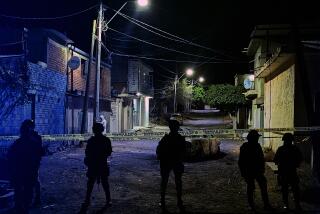Seabees team makes history in Afghanistan
It was an unusual job even for the Seabees, the U.S. Navy’s construction forces trained to hold a hammer in one hand and a Beretta M9 in the other.
First, the team selected to build barracks high in the mountains of Afghanistan consisted of eight women, who are all stationed at Naval Base Ventura County. And second, the women completed the job far ahead of schedule.
Beating deadline made up for long days and freezing nights in tents without plumbing, building four 20-by-30-foot structures, said Gafayat Moradeyo, the mission commander. But when the women returned to Bagram air field, their Afghanistan base, they learned that they had nailed another achievement: a place in naval history.
Military officials say they are the first all-female construction team to take on a construction job from start to finish in the Seabees’ 70-year history. And they did it in record time in the barren rocky mountains of Helmand province, a Taliban stronghold and the focus of recent combat efforts.
At first, the women had their doubts about the achievement. But after checking with military historians and naval museums, they confirmed their status, said Shelby Lutrey, 29, one of the builders.
“It’s definitely something to be proud of,” she said. “There is nothing wrong with hard work and good results.”
The Seabees were created during World War II to fill a critical demand for construction workers who could also fight. Today, there are nine battalions operating out of two U.S. bases, deploying overseas to build airstrips, bridges, roads, living quarters, just about anything needed in a military operation.
Women first joined the Seabees in 1972 and, 22 years later, earned the right to serve alongside their male counterparts in combat zones, said Russell Stewart, a spokesman with the U.S. Naval Mobile Construction Battalion Four.
The team members have been deployed to Iraq and Afghanistan for years — some are on their third overseas tours. In mid-November, when the call went out for a team of Seabees to build barracks huts, the women put up their hands, Stewart said.
There weren’t a lot of male Seabees available at the time, and Moradeyo, from the Chicago area, saw it as an opportunity for the women to prove themselves. At Bagram air base, the mission commander gathered her team, laid out what needed to be done, assembled the building materials and packed a pallet of construction tools for the trip to Helmand province.
Moradeyo and Lutrey, who are still in Afghanistan and were interviewed by phone, demurred when asked if they got any ribbing from their male counterparts. But Stewart, the Seabee spokesman, said that, initially, there was plenty of skepticism.
“Unlike most times Seabees show up to a new location, this team was welcomed with rolling eyes and comments on the order of, ‘Really, a group of girls?’” Stewart said.
The builders reportedly changed minds in short order. Working 12-hour days, they agreed on site to double the size of their task, adding an operations center and a gym to the barracks already planned.
Mornings were so cold that ice coated the piles of wood, soaking their gloves as they began throwing up the buildings. They took showers using freezing water pulled by bucket from a well. They ate rice and beans. They disposed of solid waste in a bag and then burned it in a pit, Lutrey said.
“When you join the military, that’s what you expect,” said the native of Scottsdale, Ariz. “It might not be the most comfortable, but it’s necessary.”
The women worked so well together that they finished the job, including installing electricity and utilities, in two weeks. It normally takes about three weeks to complete such a project, Seabees officials said.
Lutrey chalked it up to a strong team spirit. They knew the post’s soldiers had been living out of tents and mud huts, she said, and they wanted to prove the team’s efficiency by quickly providing more comfortable shelter.
“It was probably one of the smoothest builds I’ve done while in Afghanistan,” said Lutrey, who’s in her third year of service. “We had a lot of camaraderie. We pushed each other to get the job done.”
Besides Moradeyo and Lutrey, the work was completed by Kadisha Lee, Carla Diazcastillo, Amber Mann, Kacie Dunlavey, Jessica Vera and Shayla Miles.
Will the team stay together? Not likely, Moradeyo said. Seabees, each with differing areas of expertise, rotate in and out of construction teams. Moradeyo, for instance, was on another assignment in an undisclosed location last week with a different group of builders — one that included men.
Though immune to the deprivations of working under austere conditions, she said stray thoughts of home enter her mind sometimes as she looks down at her cracked hands and dirt-rimmed nails.
“I think, ‘Oh my god, I need to get a manicure,’” she said. “And then I keep going.”
catherine.saillant@latimes.com
More to Read
Start your day right
Sign up for Essential California for news, features and recommendations from the L.A. Times and beyond in your inbox six days a week.
You may occasionally receive promotional content from the Los Angeles Times.







